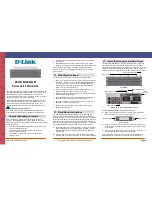
Default Setting
Feature
The factory-assigned default hostname is Switch.
Hostname
No password is defined.
Telnet password
Disabled.
Cluster command switch functionality
No cluster name is defined.
Cluster name
DHCP-Based Autoconfiguration Overview
DHCP provides configuration information to Internet hosts and internetworking devices. This protocol consists
of two components: one for delivering configuration parameters from a DHCP server to a device and an
operation for allocating network addresses to devices. DHCP is built on a client-server model, in which
designated DHCP servers allocate network addresses and deliver configuration parameters to dynamically
configured devices. The switch can act as both a DHCP client and a DHCP server.
During DHCP-based autoconfiguration, your switch (DHCP client) is automatically configured at startup
with IP address information and a configuration file.
With DHCP-based autoconfiguration, no DHCP client-side configuration is needed on your switch. However,
you need to configure the DHCP server for various lease options associated with IP addresses.
If you want to use DHCP to relay the configuration file location on the network, you might also need to
configure a Trivial File Transfer Protocol (TFTP) server and a Domain Name System (DNS) server.
The DHCP server for your switch can be on the same LAN or on a different LAN than the switch. If the
DHCP server is running on a different LAN, you should configure a DHCP relay device between your switch
and the DHCP server. A relay device forwards broadcast traffic between two directly connected LANs. A
router does not forward broadcast packets, but it forwards packets based on the destination IP address in the
received packet.
DHCP-based autoconfiguration replaces the BOOTP client functionality on your switch.
DHCP Client Request Process
When you boot up your switch, the DHCP client is invoked and requests configuration information from a
DHCP server when the configuration file is not present on the switch. If the configuration file is present and
the configuration includes the
ip address dhcp
interface configuration command on specific routed interfaces,
the DHCP client is invoked and requests the IP address information for those interfaces.
This is the sequence of messages that are exchanged between the DHCP client and the DHCP server.
Figure 108: DHCP Client and Server Message Exchange
Consolidated Platform Configuration Guide, Cisco IOS Release 15.2(4)E (Catalyst 2960-X Switches)
1561
Information About Performing Switch Setup Configuration
Summary of Contents for Catalyst 2960 Series
Page 96: ......
Page 196: ......
Page 250: ......
Page 292: ......
Page 488: ......
Page 589: ...P A R T VI Cisco Flexible NetFlow Configuring NetFlow Lite page 509 ...
Page 590: ......
Page 619: ...P A R T VII QoS Configuring QoS page 539 Configuring Auto QoS page 645 ...
Page 620: ......
Page 750: ......
Page 1604: ......
Page 1740: ......
Page 2105: ...P A R T XII Configuring Cisco IOS IP SLAs Configuring Cisco IP SLAs page 2025 ...
Page 2106: ......
Page 2118: ......
Page 2164: ......
















































